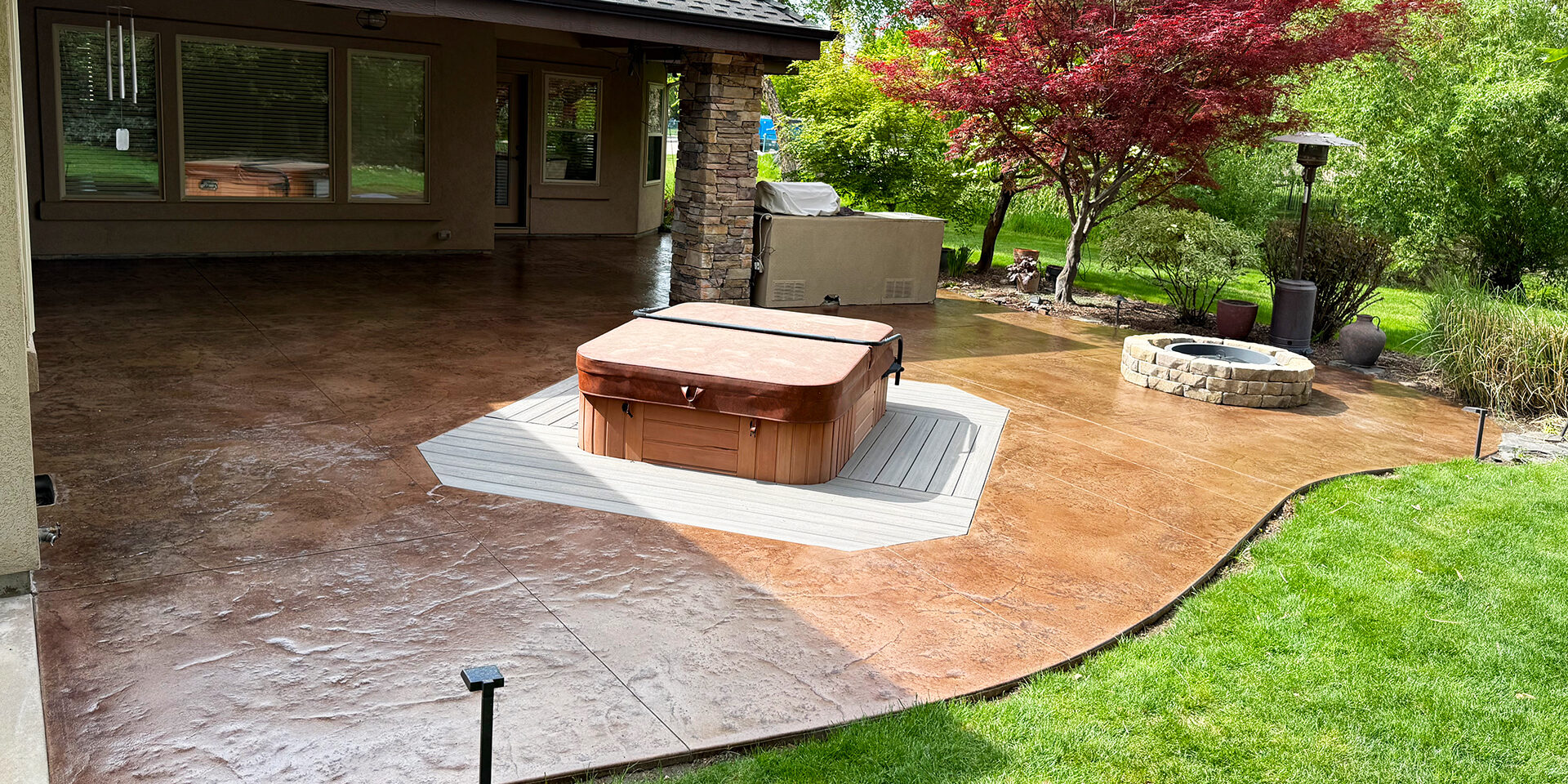Re-Sealing Your Concrete Patio
The Importance of Re-Sealing Your Concrete Patio… Lets discuss protection, beauty, and the challenges of doing it yourself (DIY).
Your finished concrete patio is more than just an outdoor space. It’s an extension of your home. It’s a place for relaxation, gatherings with friends and family, and making memories. However, exposure to the elements and regular old foot traffic can take a toll on its surface. This leads to cracks, stains, wear patterns, and a dull appearance. Re-sealing your concrete patio is a critical maintenance step that not only protects the substrate but also enhances its aesthetic appeal. While the idea of tackling this project yourself might seem appealing, re-sealing can be tricky due to the nature of sealers and the need for proper surface preparation. Lets explore why re-sealing is essential, how it preserves and beautifies your patio, and why achieving a long-lasting bond can be challenging without the right approach.
Why Re-Sealing Your Concrete Patio Matters
Concrete is a durable material, but it’s not impervious to damage. Its porous nature makes it susceptible to water infiltration, food spills, UV degradation, and freeze-thaw cycles. All of this can lead to cracks, spalling, or surface deterioration. A quality sealer acts as a protective barrier, shielding the concrete from these threats. Here’s how re-sealing benefits your patio:
-
Protects The Substrate: A sealer penetrates the top of the concrete’s pores and forms a protective film on the surface. This reduces water absorption and prevents damage from moisture-related issues like cracking or mold growth. It also guards against stains from oil, grease, or food spills, which can penetrate unsealed concrete and become permanent.
-
Extends Longevity: By minimizing wear and tear, re-sealing helps your patio withstand the test of time. Regular maintenance can prevent costly repairs or the need for a full replacement, saving you money in the long run.
-
Enhances Beauty: Sealers can transform the look of your patio, adding a glossy or satin finish that highlights the concrete’s natural texture or color. Some sealers even allow for tinting or decorative effects, giving your patio a fresh, finished appearance that boosts the aesthetic appeal.
The Challenges of DIY Re-Sealing
While re-sealing might seem like a straightforward task, it’s not as simple as applying a new coat of sealer. Sealers are designed to repel substances, which makes re-sealing a previously sealed surface particularly challenging. Here’s why:
-
Sealers Resist Adhesion: Sealers are formulated to bond with porous substrates like bare concrete, where they can penetrate and anchor into the material. However, a previously sealed surface is non-porous, meaning new sealer struggles to adhere properly. Without proper preparation, the new sealer may peel, flake, or fail to bond, leading to a patchy finish that looks horrible.
-
Surface Preparation Is Critical: For a new sealer to adhere to an existing sealed surface, the patio must be thoroughly cleaned and abraded. Cleaning removes dirt, grease, mold, and contaminants that can interfere with bonding. While abrading (e.g., going over the surface with a floor machine equipped with an abrasive pad) creates a rough texture for the new sealer to grip. These steps require specialized equipment, such as a high psi pressure washer and a floor machine and specialty abrasive pads, which may not be readily available to homeowners. Improper preparation can result in a weak bond and leads to the sealer quickly flaking up.
-
Choosing The Right Sealer: Not all sealers are compatible with previously sealed surfaces. Standard sealers may not bond well to inorganic materials like old sealers, leading to adhesion issues. To achieve a long-lasting re-seal, it’s essential to select a sealer specifically designed to adhere to inorganic surfaces or existing coatings. These products are formulated to form a strong, durable bond, ensuring the new layer of protection lasts for years.
Tips for Successful Re-Sealing
If you’re determined to re-seal your patio yourself, here are a few tips to improve your chances of success:
-
Clean Thoroughly: Use a pressure washer and a concrete-safe degreaser to remove all dirt, stains, and residues. Pay special attention to areas with grease or oil, as these can prevent adhesion.
-
Abrade The Surface: Lightly sand the surface with a rental floor machine equipped with an abrasive pad to create a texture that promotes bonding. Follow the rental company’s instructions carefully to avoid damaging the concrete.
-
Choose The Right Sealer: Look for a sealer labeled as compatible with previously sealed surfaces or designed for inorganic materials. I personally use Versatec nano-quartz sealer for my clients. It offers strong adhesion and durability, especially when applying over old sealers.
-
Test First: Before applying the sealer to the entire patio, test it on a small, inconspicuous area to ensure proper adhesion and the desired finish.
-
Apply Correctly: Follow the manufacturer’s guidelines for application, including temperature and weather conditions. Most sealers require a dry surface and moderate temperatures (typically 50–90°F) for optimal results.
When to Call a Professional
Given the complexities of re-sealing, hiring a professional may be the best option for many homeowners. Professionals have access to commercial grade equipment for cleaning and abrading, as well as expertise in selecting and applying the right sealer for your patio’s specific needs. They can ensure a strong bond and a flawless finish, saving you time and potential frustration. While DIY re-sealing might save money upfront, simple mistakes can lead to costly repairs or the need to redo the job sooner than expected.
Conclusion
Re-sealing your concrete patio is a vital step in protecting its surface and maintaining its beauty. A properly sealed patio resists water, stains, and UV damage, extending its lifespan and keeping it looking vibrant for years. However, re-sealing is not without its challenges. The non-porous nature of a sealed surface makes adhesion difficult, and proper cleaning, abrading, and sealer selection are critical for a lasting bond. While DIY re-sealing is possible, it requires the right tools, techniques, and products… otherwise, you risk crappy results. For the best outcome, consider investing in a sealer designed for inorganic surfaces like Versatec. On the other hand, consulting a professional isn’t a bad idea. These options will ensure your patio remains a stunning and durable outdoor oasis. By prioritizing re-sealing, you’ll enjoy a beautiful patio with your friends and family for seasons to come… yay!
Check out a brief video I made on the subject a while back HERE.








